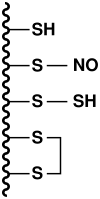Hydrogen sulfide as a gasotransmitter
- PMID: 20067586
- PMCID: PMC2965526
- DOI: 10.1111/j.1471-4159.2010.06580.x
Hydrogen sulfide as a gasotransmitter
Abstract
Nitric oxide (NO) and carbon monoxide (CO) are well established as messenger molecules throughout the body, gasotransmitters, based on striking alterations in mice lacking the appropriate biosynthetic enzymes. Hydrogen sulfide (H(2)S) is even more chemically reactive, but until recently there was little definitive evidence for its physiologic formation. Cystathionine beta-synthase (EC 4.2.1.22), and cystathionine gamma-lyase (CSE; EC 4.4.1.1), also known as cystathionine, can generate H(2)S from cyst(e)ine. Very recent studies with mice lacking these enzymes have established that CSE is responsible for H(2)S formation in the periphery, while in the brain cystathionine beta-synthase is the biosynthetic enzyme. Endothelial-derived relaxing factor activity is reduced 80% in the mesenteric artery of mice with deletion of CSE, establishing H(2)S as a major physiologic endothelial-derived relaxing factor. H(2)S appears to signal predominantly by S-sulfhydrating cysteines in its target proteins, analogous to S-nitrosylation by NO. Whereas S-nitrosylation typically inhibits enzymes, S-sulfhydration activates them. S-nitrosylation basally affects 1-2% of its target proteins, while 10-25% of H(2)S target proteins are S-sulfhydrated. In summary, H(2)S appears to be a physiologic gasotransmitter of comparable importance to NO and carbon monoxide.
Keywords: EDHF; EDRF; GAPDH; KATP; S-sulfhydration; cystathionase; cystathionine β-synthase; cystathionine γ-lyase; hydrogen sulfide; hydropersulfide.
Figures




Similar articles
-
Hydrogen sulfide as endothelium-derived hyperpolarizing factor sulfhydrates potassium channels.Circ Res. 2011 Nov 11;109(11):1259-68. doi: 10.1161/CIRCRESAHA.111.240242. Epub 2011 Oct 6. Circ Res. 2011. PMID: 21980127 Free PMC article.
-
H₂S signalling through protein sulfhydration and beyond.Nat Rev Mol Cell Biol. 2012 Jul 11;13(8):499-507. doi: 10.1038/nrm3391. Nat Rev Mol Cell Biol. 2012. PMID: 22781905 Review.
-
Hydrogen sulfide: a new EDRF.Kidney Int. 2009 Oct;76(7):700-4. doi: 10.1038/ki.2009.221. Epub 2009 Jun 17. Kidney Int. 2009. PMID: 19536086 Review.
-
CD4+ T-Cell Endogenous Cystathionine γ Lyase-Hydrogen Sulfide Attenuates Hypertension by Sulfhydrating Liver Kinase B1 to Promote T Regulatory Cell Differentiation and Proliferation.Circulation. 2020 Nov 3;142(18):1752-1769. doi: 10.1161/CIRCULATIONAHA.119.045344. Epub 2020 Sep 9. Circulation. 2020. PMID: 32900241
-
A critical role for cystathionine-β-synthase in hydrogen sulfide-mediated hypoxic relaxation of the coronary artery.Vascul Pharmacol. 2017 Aug;93-95:20-32. doi: 10.1016/j.vph.2017.05.004. Epub 2017 May 25. Vascul Pharmacol. 2017. PMID: 28552745
Cited by
-
L-Cysteine Desulfhydrase 1 modulates the generation of the signaling molecule sulfide in plant cytosol.Plant Signal Behav. 2013 May;8(5):e24007. doi: 10.4161/psb.24007. Epub 2013 Feb 21. Plant Signal Behav. 2013. PMID: 23428891 Free PMC article.
-
Interaction between hydrogen sulfide-induced sulfhydration and tyrosine nitration in the KATP channel complex.Am J Physiol Gastrointest Liver Physiol. 2015 Mar 15;308(6):G532-9. doi: 10.1152/ajpgi.00281.2014. Epub 2014 Dec 31. Am J Physiol Gastrointest Liver Physiol. 2015. PMID: 25552582 Free PMC article.
-
Ratiometric QD-FRET Sensing of Aqueous H2S in Vitro.Anal Chem. 2016 Jun 7;88(11):6050-6. doi: 10.1021/acs.analchem.6b01310. Epub 2016 May 23. Anal Chem. 2016. PMID: 27156947 Free PMC article.
-
Upregulation of Tolerogenic Pathways by the Hydrogen Sulfide Donor GYY4137 and Impaired Expression of H2S-Producing Enzymes in Multiple Sclerosis.Antioxidants (Basel). 2020 Jul 10;9(7):608. doi: 10.3390/antiox9070608. Antioxidants (Basel). 2020. PMID: 32664399 Free PMC article.
-
Therapeutic importance of hydrogen sulfide in age-associated neurodegenerative diseases.Neural Regen Res. 2020 Apr;15(4):653-662. doi: 10.4103/1673-5374.266911. Neural Regen Res. 2020. PMID: 31638087 Free PMC article. Review.
References
-
- Abeles RH, Walsh CT. Acetylenic enzyme inactivators. Inactivation of γ-cystathionase, in vitro and in vivo, by propargyl glycine. J Am Chem Soc. 1973;95:6124–6125. - PubMed
-
- Abott MH, Folstein SE, Abbey H, Pyeritz RE. Psychiatric manifestations of homocystinuria due to cystathionine β-synthase deficiency: Prevalence, natural history, and relationship to neurologic impairment and vitamin B6-responsiveness. Am J Med Genet. 1987;26:959–969. - PubMed
Publication types
MeSH terms
Substances
Grants and funding
LinkOut - more resources
Full Text Sources
Other Literature Sources
Research Materials
Miscellaneous

